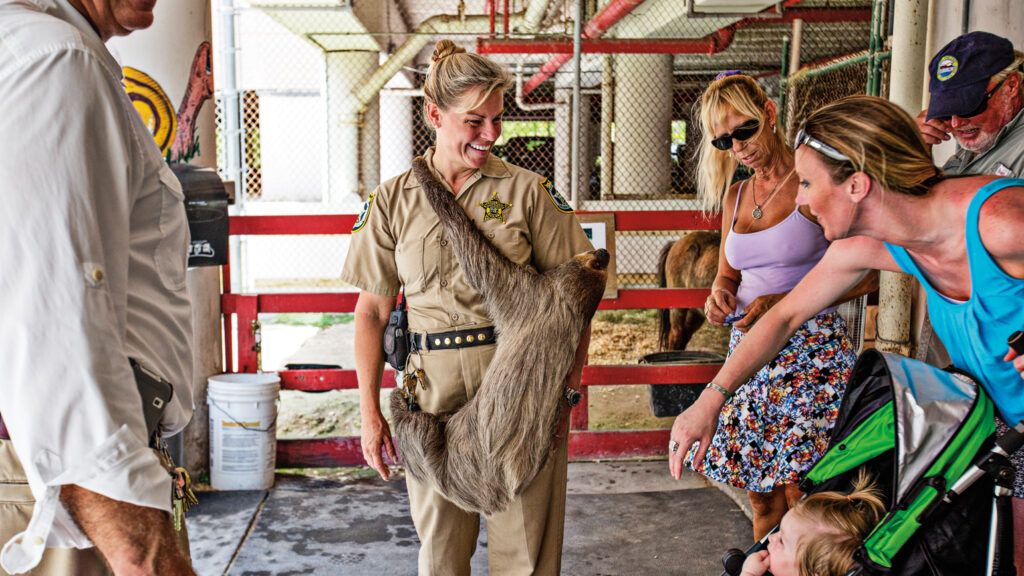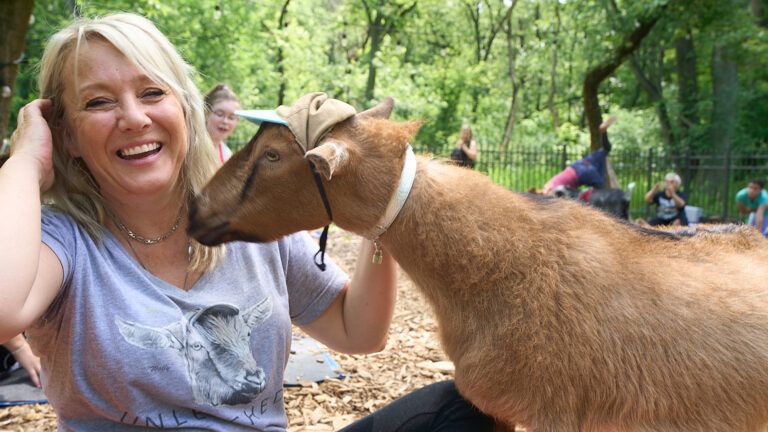The Florida Keys are known for beautiful beaches, vibrant nightlife and the only living coral barrier reef in North America. But word has spread about a unique zoo on Stock Island, just a couple of miles north of popular Key West. It’s not the animals that folks are buzzing about—though there are some unusual creatures there—but rather the location: a jail. Curator Jeanne Selander, also known as Farmer Jeanne, never imagined she’d be caring for animals alongside inmates, but now she wouldn’t want to be anywhere else.
How did the Monroe County Sheriff’s Office Animal Farm on Stock Island come to be?
Across the street from the Stock Island Detention Center there’s a golf course with a pond. Ducks were crossing the road on their way to the pond and getting hit by cars. It was a real hazard. Down here in the Keys, we’re in a flood zone where everything is raised up, including the jail, which sits atop 11-foot stilts. In 1994, a deputy had the idea to place the ducks in a fenced area under the jail, and the sheriff approved. The inmates rounded them up, and the landscaper was asked to feed them regularly.
How did more animals join the ducks?
Rumors circulated—we call it the “coconut telegraph” around here—that the sheriff was allowing more animals into the enclosure. So people started dropping off animals in need of a home. There was a pig, chickens and a blind horse named Angel. The whole thing was accidental. Folks originally called it a farm, but when I brought in exotic animals, it became an official zoo in the eyes of the U.S. Department of Agriculture. Truthfully, it’s a sanctuary.
What were you doing before you came to the zoo?
I’ve always loved animals. I have a marine biology degree and was assistant curator at the Key West Aquarium for seven years. The veterinarian who had been checking on the animals at the jail told me about a job opening to manage the zoo. It was so run-down, but I saw so much potential. The sheriff hired me, and here I am 12 years later!
Tell us about the 150 animals there today.
There were only 20 animals when I arrived. Our sloth, Mo, is the most popular. Our alpaca, Snowflake, loves to give kisses, and our emu, Kramer, was given to us by an emu farm. The other residents include a lemur, a skunk, a kinkajou [a relative of the raccoon], a donkey, a miniature horse, pigs, snakes, sheep, goats, tortoises, prairie dogs, cockatiels, geese, ducks, Patagonian cavies [large rodents] and a bull.
Aside from the emu, how do the animals come to you?
We mostly get what I call pet shop casualties. People buy snakes or birds and don’t take the time to learn how to care for them. So the majority of the zoo residents are pets—abandoned, abused, confiscated, or donated. People used to just drop them off, but we’re so popular now, people have to call first and ask if we have room.
Which inmates get to work at the zoo?
They need to be nonviolent; no sexual or child offenders allowed. They have to love animals. Some inmates’ sentences require work, so they try out working at the zoo to see if they like it. Some volunteer and some work here to earn a shorter sentence. We have four inmates at a time.
Were you worried about working with prisoners?
I took a class in which the sergeant at the jail teaches you what inmates can and can’t do, what you can and can’t do, and how to handle the situation if you’re held hostage or caught up in a fight. I thought, “What have I gotten myself into?”
What does the work involve for the inmates?
It’s an eight-hour day that includes feeding, watering and cleaning. If the vet is coming, inmates assist with grooming and habitat construction; they built a butterfly habitat recently. On open-house days they work with the public. They’ll take out animals for kids to pet, and they’ll interact with folks who ask questions. Though they’re required to work six days a week, most come in on their day off. It’s a lot of work, and I couldn’t do it without them.
But last year you were forced to work without them, right?
Yes, thanks to Hurricane Irma. As the storm got closer, the sheriff decided to move the inmates to safety, but it was too late for the animals and me. We turned to plan B. I called my inmates, and we worked until 4 a.m. moving all the animals, including the horses, the sloth and the pigs, up into the jail cells. The prisoners went to Palm Beach County Jail. I lived here with no power for two weeks, caring for the animals. There was no phone service or internet, so people didn’t know that I was here. Eventually, I posted on Facebook that the jail had become the Ark. It garnered hundreds of messages from followers asking, “How are Farmer Jeanne and the animals?”
What do the inmates get out of the program?
They gain self-esteem and a sense of pride. They’re invested—building things and caring for animals while getting positive feedback from the public. They’re helping the community, learning compassion and receiving unconditional love from the animals. Many have come up to me on the street after they’ve been released, telling me, “The zoo saved me.” They leave here knowing they made a difference.
Have any of them gone on to work with animals once they’re out?
Some have volunteered at the ASPCA. All these inmates are here for less than a year, so it’s too short a time to really learn a trade. But many have come back to show their families what they accomplished. They’re proud.
How did this zoo become so popular?
It’s a unique program. Local kids may not otherwise see these animals since the closest zoo is in Miami, 160 miles away. Visitors learn about animals and see that inmates are being productive and giving back. It’s open to the public on the second and fourth Sunday of each month. When it first opened, there were only 12 visitors on Sunday, and now we get 300.
How is it funded?
It’s run entirely on donations. Because so many people love the animals and the program, they give quite a bit. The community is so supportive. Our basic costs for feed, veterinary care and habitat maintenance are around $25,000 per year, but there are always extra costs that pop up. I’ll often get discounts from the big stores like Home Depot.
What do your community events include?
That’s the most important thing I started. I drive the animals around in a trailer to engage the public and teach them about these creatures and our program. I do events at parks, schools, Rotary clubs and Naval Air Station Key West Sigsbee. I also bring Mo to the library and read books to an audience while he’s hanging on me. People love sloths.
How else have you helped bridge a community connection?
With poop! Over time, the shavings that make up the animal beds get mixed with poop, so we put the mulch into old feed bags and give it away. Why spend money to have it hauled away when people pick it up for their gardens? We call it zoo poo!
Do you think this program would work elsewhere?
I think it’s amazing. My goal is to start it up in other places, so I’m talking to other jails. I’ve heard of inmates training horses and working with shelter dogs, but no other jail has a zoo. There’s nothing like working with animals to heal someone. I’m so grateful for the sheriff for wanting to have it.
Have you found your calling here?
Absolutely. I have found my labor of love. It’s about the love of the animals, the love of the program and experiencing something new every day. I’m so fortunate.
Did you enjoy this story? Subscribe to All Creatures magazine.





